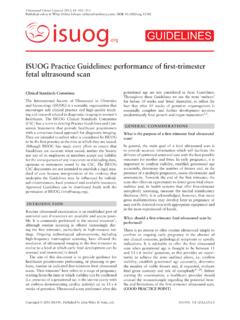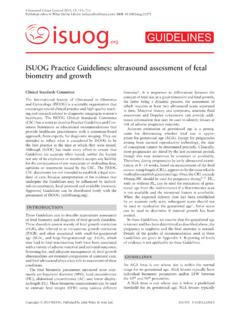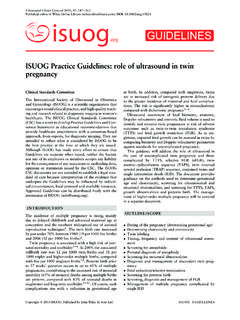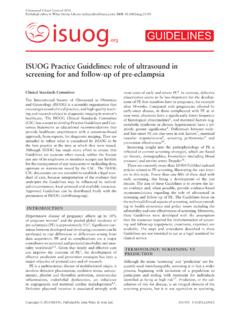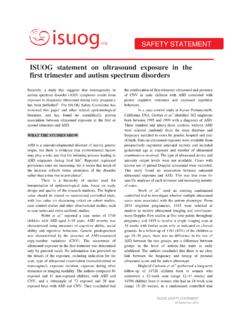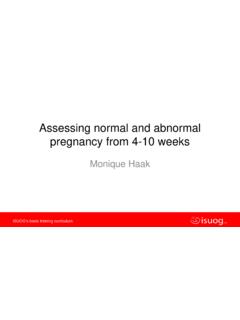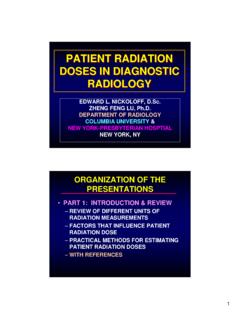Transcription of ISUOG Practice Guidelines: performance of firsttrimester ...
1 Ultrasound Obstet Gynecol 2013; 41: 102 113. Published online in Wiley Online Library ( ). DOI: ISUOG .org guidelines . ISUOG Practice guidelines : performance of first-trimester fetal ultrasound scan Clinical Standards Committee gestational age are not considered in these guidelines . Throughout these guidelines we use the term embryo'. The International Society of Ultrasound in Obstetrics for before 10 weeks and fetus' thereafter, to reflect the and Gynecology ( ISUOG ) is a scientific organization that fact that after 10 weeks of gestation organogenesis is encourages safe clinical Practice and high-quality teach- essentially complete and further development involves ing and research related to diagnostic imaging in women's predominantly fetal growth and organ maturation2,3 . healthcare. The ISUOG Clinical Standards Committee (CSC) has a remit to develop Practice guidelines and Con- sensus Statements that provide healthcare practitioners GENERAL CONSIDERATIONS.
2 With a consensus-based approach for diagnostic imaging. What is the purpose of a first-trimester fetal ultrasound They are intended to reflect what is considered by ISUOG scan? to be the best Practice at the time at which they are issued. Although ISUOG has made every effort to ensure that In general, the main goal of a fetal ultrasound scan is guidelines are accurate when issued, neither the Society to provide accurate information which will facilitate the nor any of its employees or members accept any liability delivery of optimized antenatal care with the best possible for the consequences of any inaccurate or misleading data, outcomes for mother and fetus. In early pregnancy, it is opinions or statements issued by the CSC. The ISUOG important to confirm viability, establish gestational age CSC documents are not intended to establish a legal stan- accurately, determine the number of fetuses and, in the dard of care because interpretation of the evidence that presence of a multiple pregnancy, assess chorionicity and underpins the guidelines may be influenced by individ- amnionicity.
3 Towards the end of the first trimester, the ual circumstances, local protocol and available resources. scan also offers an opportunity to detect gross fetal abnor- Approved guidelines can be distributed freely with the malities and, in health systems that offer first-trimester permission of ISUOG aneuploidy screening, measure the nuchal translucency thickness (NT). It is acknowledged, however, that many gross malformations may develop later in pregnancy or INTRODUCTION may not be detected even with appropriate equipment and in the most experienced of hands. Routine ultrasound examination is an established part of antenatal care if resources are available and access possi- When should a first-trimester fetal ultrasound scan be ble. It is commonly performed in the second trimester1 , performed? although routine scanning is offered increasingly dur- ing the first trimester, particularly in high-resource set- There is no reason to offer routine ultrasound simply to tings.
4 Ongoing technological advancements, including confirm an ongoing early pregnancy in the absence of high-frequency transvaginal scanning, have allowed the any clinical concerns, pathological symptoms or specific resolution of ultrasound imaging in the first trimester to indications. It is advisable to offer the first ultrasound evolve to a level at which early fetal development can be scan when gestational age is thought to be between 11. assessed and monitored in detail. and 13 + 6 weeks' gestation, as this provides an oppor- The aim of this document is to provide guidance for tunity to achieve the aims outlined above, confirm healthcare practitioners performing, or planning to per- viability, establish gestational age accurately, determine form, routine or indicated first-trimester fetal ultrasound the number of viable fetuses and, if requested, evaluate scans. First trimester' here refers to a stage of pregnancy fetal gross anatomy and risk of aneuploidy4 20.
5 Before starting from the time at which viability can be confirmed starting the examination, a healthcare provider should ( presence of a gestational sac in the uterine cavity with counsel the woman/couple regarding the potential bene- an embryo demonstrating cardiac activity) up to 13 + 6 fits and limitations of the first-trimester ultrasound scan. weeks of gestation. Ultrasound scans performed after this (GOOD Practice POINT). Copyright 2013 ISUOG . Published by John Wiley & Sons, Ltd. ISUOG guidelines . ISUOG guidelines 103. Who should perform the first-trimester fetal ultrasound What if the examination cannot be performed in scan? accordance with these guidelines ? Individuals who perform obstetric scans routinely should These guidelines represent an international benchmark have specialized training that is appropriate to the Practice for the first-trimester fetal ultrasound scan, but consider- of diagnostic ultrasound for pregnant women.
6 (GOOD ation must be given to local circumstances and medical Practice POINT) practices . If the examination cannot be completed in To achieve optimal results from routine ultrasound accordance with these guidelines , it is advisable to doc- examinations it is suggested that scans should be per- ument the reasons for this. In most circumstances, it will formed by individuals who fulfill the following criteria: be appropriate to repeat the scan, or to refer to another healthcare practitioner. This should be done as soon as 1. have completed training in the use of diagnostic ultra- possible, to minimize unnecessary patient anxiety and sonography and related safety issues; any associated delay in achieving the desired goals of the 2. participate in continuing medical education activities; initial examination. (GOOD Practice POINT). 3. have established appropriate care pathways for suspi- cious or abnormal findings.
7 4. participate in established quality assurance What should be done in case of multiple pregnancies? programs21 . Determination of chorionicity and amnionicity is impor- tant for care, testing and management of multifetal preg- What ultrasonographic equipment should be used? nancies. Chorionicity should be determined in early preg- It is recommended to use equipment with at least the nancy, when characterization is most reliable26 28 . Once following capabilities: this is accomplished, further antenatal care, including the timing and frequency of ultrasound examinations, should real-time, gray-scale, two-dimensional (2D) ultrasound;. be planned according to the available health resources transabdominal and transvaginal ultrasound and local guidelines . (GOOD Practice POINT). transducers;. adjustable acoustic power output controls with output display standards; guidelines FOR EXAMINATION. freeze frame and zoom capabilities.
8 Electronic calipers; 1. Assessment of viability/early pregnancy capacity to print/store images;. regular maintenance and servicing. In this Guideline, age' is expressed as menstrual or ges- tational age, which is 14 days more than conceptional age. Embryonic development visualized by ultrasound How should the scan be documented? closely agrees with the developmental time schedule'. An examination report should be produced as an elec- of human embryos described in the Carnegie staging tronic and/or paper document (see Appendix for an system3 . The embryo is typically around 1 2 mm long example). Such a document should be stored locally and, when first detectable by ultrasound and increases in length in accordance with local protocol, made available to by approximately 1 mm per day. The cephalic and caudal the woman and referring healthcare provider. (GOOD ends are indistinguishable until 53 days (around 12 mm), Practice POINT) when the diamond-shaped rhombencephal cavity (future fourth ventricle) becomes visible18.
9 Is prenatal ultrasonography safe during the first trimester? Defining viability fetal exposure times should be minimized, using the short- The term viability' implies the ability to live indepen- est scan times and lowest possible power output needed to dently outside the uterus and, strictly speaking, cannot be obtain diagnostic information using the ALARA (As Low applied to embryonic and early fetal life. However, this As Reasonably Achievable) principle. (GOOD PRAC- term has been accepted in ultrasound jargon to mean that TICE POINT) the embryonic or fetal heart is seen to be active and this is Many international professional bodies, including taken to mean the conceptus is alive'. fetal viability, from ISUOG , have reached a consensus that the use of B- an ultrasound perspective, is therefore the term used to mode and M-mode prenatal ultrasonography, due to its confirm the presence of an embryo with cardiac activity at limited acoustic output, appears to be safe for all stages of the time of examination.
10 Embryonic cardiac activity has pregnancy22,23 . Doppler ultrasound is, however, associ- been documented in normal pregnancies at as early as 37. ated with greater energy output and therefore more poten- days of gestation29 , which is when the embryonic heart tial bioeffects, especially when applied to a small region of tube starts to beat30 . Cardiac activity is often evident interest24,25 . Doppler examinations should only be used in when the embryo measures 2 mm or more31 , but is not the first trimester, therefore, if clinically indicated. More evident in around 5 10% of viable embryos measuring details are available in the ISUOG Safety Statement22 . between 2 and 4 mm32,33 . Copyright 2013 ISUOG . Published by John Wiley & Sons, Ltd. Ultrasound Obstet Gynecol 2013; 41: 102 113. 104 ISUOG guidelines Defining an intrauterine pregnancy The presence of an intrauterine gestational sac clearly signifies that the pregnancy is intrauterine, but the cri- teria for the definition of a gestational sac are unclear.
